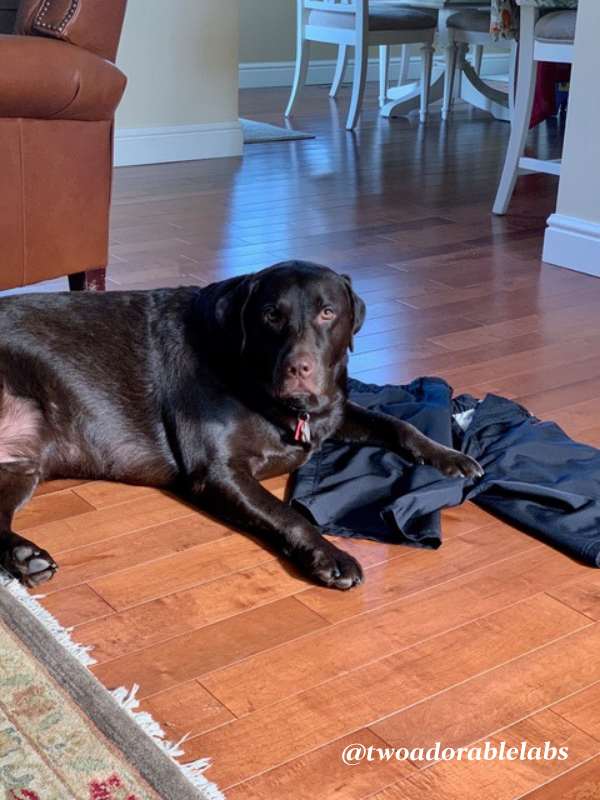A Checklist For Dog Owners Expecting Pups
Saturday morning with the pups!
They love trying to both lay on their daddy in his chair at the same time!

Your female should be fed a premium quality adult dog food until week 4 of pregnancy when puppy food should gradually be added to the diet. Royal Canin, Hills, or Eukanuba will provide guaranteed quality. She should be consuming entirely puppy food (high calcium/protein) by her last week of pregnancy.
Examples of good quality puppy foods available from MedicAnimal.
Royal Canin Starter Mother & Babydog Dry Adult & Puppy Dog Food
• Perfecting for weaning puppies
• Meets the needs of the mother as well as support both immune systems
• Contains essential nutrients including protein, rice, animal fats, vegetable protein
• Specially manufactured kibble for smaller mouths
• Supports digestive health and immune systems
Hill’s Science Plan Puppy Healthy Development
• specially developed for medium-sized dogs less than a year old
• contains added omega-3 and DHA from fish oil to support joint and bone health
• antioxidants help to support a growing immune system
• nutritionally balanced
• easy to digest
Canine Choice Puppy (Grain Free)
• 60% meat
• Energy content adjusted to the metabolism of puppies
• Cranberry, rosemary and rosehip to support the immune system
• Prebiotics, probiotics, chicory and camomile to improve digestion and relieve irritation
• A grain-free formula
• No soy, artificial colors or preservatives
Purina Pro Plan Opti Puppy Range
• special OPTI blend of ingredients especially for medium-sized puppies
• colostrum boosts your dog’s natural immune defences
• great flavour your pet will love
• natural ingredients
• supports bone and joint growth
• encourages and supports an active lifestyle.

2. Whelping Box
– Introduce the whelping box to your dog
– Once you have purchased or built your whelping box, take some time to get your dog accustomed to it. Dogs look for warm, safe places to deliver their puppies. If you don’t introduce her to the whelping box beforehand, she might decide to deliver someplace else—like your closet.
– Encourage the pregnant female to sleep and sit in the box regularly. That helps her get used to being in there. If you install a heat lamp, that might make her more likely to go in it, and it will also help the puppies retain body heat after they’re born.
– Make sure the sides are high enough so that the puppies will not fall out and to prevent draft.
– The box should be big enough for your dog to stretch out so that delivery is more comfortable for her.
– The box should be made comfortable with extra towels and to make delivery comfortable.
– Place the whelping box in a warm, quiet area which is free from distractions but familiar to the dog as she needs a quiet and secure place to rest.
-Keep clean at all times.
– For bigger breeds, a security bar around the internal surface is often recommended. This will prevent a puppy placed in a corner being crushed or suffocated by his mother accidentally.
– Plastic sheets should layer the floor of the box covered with newspapers or puppy training pads. They make excellent bedding material because they are easy for the mother to shred for her nest, are absorbent, and can be replaced.
– Blankets, rugs, and towels are also useful, but they must be cleaned frequently.
– A waterproof heating pad under the box will serve as an additional heat source. It is very important to make sure you do not put a heating pad in the box where a puppy could contact or lie on it directly as they could get burned.
– Make sure when the puppies start moving around, you provide a safe area for them to stretch their legs.
– Ideally, set up the whelping box away from all other dogs and in a quieter area to give the mom privacy.
– Put a tarp or plastic drop cloth underneath and around the box in case of accidents.
Whelping Supply Checklist:
• Newspaper to line the whelping box during delivery for easy clean up
• Non-skid bath mats for bedding after whelping is done
• Dry, clean towels to clean the puppies
• Paper towels to help with clean up
• Thermometer to check your dog’s temperature before whelping
• Unwaxed dental floss to tie off the umbilical cords
• Clean scissors to cut the umbilical cords
• A heating pad or hot water bottle to keep the puppies warm (be careful of it not being too hot)
• Iodine to clean the puppies’ abdomens after the cord is cut and dab on the end of the cut umbilical cord
• A baby scale in ounces
• Your veterinarian’s phone number and the number of a nearby emergency clinic
A great recourse to read if your pup is pregnant and ready to deliver. You will be in for an experience and if this is your first time, educate yourself so that if something goes wrong, you can be more prepared: https://www.akc.org/expert-advice/health/dog-pregnancy-care-prep/
I'll fold these shorts for you mom!
Never mind :-). It’s Saturday morning. Too early to do any house work!

3. Milk replacers
- If your dog experiences any problems post whelping, the puppies may require hand-feeding, in which case commercial milk replacement formulas should be on hand to syringe into the puppies mouths on regular intervals. If any of the puppies are particularly weak or small, PuppyStim will give an instant energy boost. A nursing kit or syringes are essential for administering milk to the pups if mum experiences any difficulties feeding. If your momma dog is not lactating, one of the best ways to improve dog milk production is providing enough liquids to the dog mom, either in the form of fresh water or chicken soup. If your dog is in a good shape but does not have enough milk then the first thing you should do is making sure that she has been supplied with plenty of water.
4. Contact your vet
- Keep your vet informed of every stage of the pregnancy.
- Inform your vet when the puppies are due, and get the information for the after-hours vet, if your local vet uses one.
- Once labour starts, you will need to call the vet if your dog is actively straining for more than half an hour without producing the first puppy, if there is 4 hours between puppies with active straining, or sooner if there appears to be more pups on the way but the bitch shows signs of exhaustion.
5. Research the signs of labor
- Examples include loss of appetite, restlessness and sometimes vomiting. This may happen about 12 hours before active labor. You don’t have to stay with her the whole time as this can make her uneasy.
- At this time, quarantine any male dogs in the house, as they don’t have the same instincts as the mother does and might become jealous and attack the puppies.
6. Check on your dog when she goes into active labor
- Puppies will start to be born about an hour after she starts active labor. Keep an eye on her but don’t bother her; animals know how to take care of their young instinctively.
- Depending on the breed, it will take several hours before the entire litter is born.
Should you have more questions, read more about dog pregnancy and birth
• Canine Pregnancy: The 7 most common problems during and post whelping
• A complete guide to caring for a pregnant bitch
• 5 FAQs about feeding your pregnant or lactating bitch
• Understanding the Worming Regime for Newborn Puppies and their Mothers

You Might Also Like
Help Jasmine Get Adopted!
Jasmine A sweet pitbull named Jasmine is sitting at the Hancock County Animal Shelter waiting for adoption. My cousin adopted Jasmine from this shelter two years ago. Sadly, my cousin passed away recently, and the police were instructed to take Jasmine directly...
Air Quality & Pets: How To Stop Your Home From Getting Musty & Smelly
As absolutely amazing as a pet is, you can’t deny that they may give your home a certain odor. You know what we’re talking about; there’s a mustiness that comes with having a pet, which can make the quality of the air feel almost thick and a bit harder to breathe in....
What Is A Velcro Dog?
Happy Wednesday, everyone! Today we are asking…What Is A Velcro Dog? All dogs have different cuddling styles and ways of showing affection. Jake loved being near me, and his favorite spot was on the couch, lying with his head in my lap while I massaged his ears and...
Cancer In Dogs
Happy Wednesday, everyone. Today, we're discussing cancer in dogs and what to look for. But first, I want to give a big thank you to all of you who called, sent texts, emails, and cards over Jake’s passing. Mr. TAL and I received messages from all over the world,...





Thank you SOOOO much for this valuable information! My dog is expecting in about 2-3 weeks so this blog has been essential to me! I look forward to being a part of your group and I’m going to encourage my dog-loving friends to join as well! Much love to you Bobbi Jo!
Awh thank you so much! I’m so glad this post helps you. I really appreciate your comment and wish you so much joy with your new puppies!